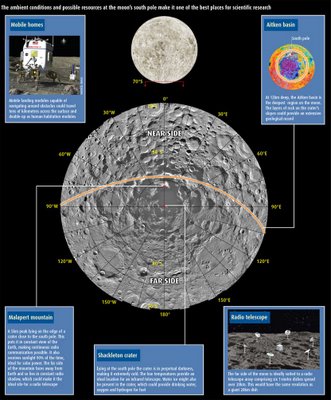“The moon,” New Scientist claims, “is about to follow the fate of Antarctica, which remained virtually untouched for nearly half a century after the first intrepid explorers penetrated its vast expanse. What followed was a mushrooming cluster of year-round laboratories, observatories and research facilities used by tens of thousands of scientists in summer and a thousand more who brave the long, dark winter.”

[Image: Where to site a lunar laboratory; New Scientist].
Deep within such a permanent lunar base, scientists will find an “interference-free environment,” which is “the perfect place to search for signs of extraterrestrial intelligence.” Though one is forced to wonder: if the scientists aren’t on Earth anymore… won’t they themselves constitute a source of extraterrestrial intelligence?
In any case, in “certain places near the poles” these scientists will find “perpetual sunlight, handy for continuous solar power; and in the shadows of crater rims, perpetual darkness, ideal for astronomy… Plus, there is a rock-steady surface on which to build structures, and the materials with which to build them.” Except – that’s not entirely true: in fact, the very real risk of “deep moonquakes,” NASA warns, is so great that the astronauts “may need quake-proof housing.”
Finally, somebody go get Barry White ’cause “there are sites available where the nights are long and uninterrupted” – and that’s all I gotta say about that.
[See also: Lunar urbanism 5, Lunar urbanism 4 – et cetera].